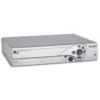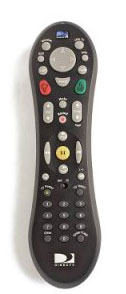DirecTV and TiVo History
Soon after TiVo was established as a company, they agreed to make combination boxes with DirecTV. These units contained by a DVR and a DirecTV satellite receiver in one box. There several advantages of having one integrated unit like this including faster and more accurate channel changes, the ability to record two programs at once, space, power outlets, etc. These units are generally referred to as "DirecTiVos."

When these units were developed, DirecTV hardware was produced by major-name home electronics companies (as opposed to now, where all DirecTV hardware has "DirecTV" as its brand name). So when DirecTV and TiVo produced their first engineering plans of hardware, three partners of DirecTV produced the actual units. The first two (Philips and Sony) were already manufacturing "standalone" (non-combination) TiVo DVRs. Philips then produced a DirecTiVo: the DSR6000. Sony made a SAT T-60. And Hughes, a subsidiary of DirecTV at the time, made a unit called the GXCEBOT. All three units were essentially the same unit inside, with different cosmetics outside, and different on-screen logos. The only other difference was that the Sony unit used a different remote - not the typical TiVo peanut remote.
  
When these three units were initially released, the software wasn't yet able to support the recording of two channels simultaneously. So the SAT 2 input had a cap on it when the units shipped from the factory. With the release of a software update, these units gained the ability to record two shows at once, as long as a second cable was run from the DirecTV dish or multi-switch and attached to the SAT 2 input. Splitting an existing cable doesn't work with DirecTV technology.
These DirecTiVos became very popular, especially once the dual-tuner recording was enabled. Many cable users changed over to DirecTV for this feature. In addition, cable customers who had problems with channel changing saw the value in having one integrated component, and many moved to DirecTV for that reason also. With the then-current state of hardware, these units clearly had all of the advantages.
In the fall of 2002, DirecTV and TiVo launched a new line of DirecTiVos. These units are often called "Series2" units, but really don't have the same networking functionality of the standalone Series2 units, and this is really where the paths of the units begins to diverge. The standalone units gain many features not available on the DirecTV units.

With this new generation of units, DirecTV included a faster processor, a new remote (above), and a totally new internal design. The first units were produced by Hughes (the HDVR2) and soon they were followed by the Philips DSR7000. Then RCA and Samsung also started producing units, and Hughes and Philips made slightly newer units with some minor design changes. Finally, when DirecTV began consolidating the hardware with their brand name, they released the DirecTV R10, and production on the other branded units totally stopped. All of these units are functionally identical and have several newer features than the first generation of DirecTiVos - notably, the folder feature in the Now Playing List.
Parallel to this development, DirecTV and TiVo produced the first ever HD TiVo DVR. This unit was also the first DVR with the DirecTV brand. The model number is the HR10-250.

The HR10-250 was a groundbreaking unit for a few reasons beyond just HD. It supported recording from OTA antenna signals as well as from DirecTV - all internally. It could do dual channel recording, just as the standard definition units could, and it could record two HD channels - even from the antenna input. Yet again, there was a big reason for cable users to move to DirecTV. If you wanted TiVo and HD, this was the only way to get it.
But the HR10-250 eventually caused a bit of a backlash for DirecTV users. Beginning in late 2006, DirecTV began to produce their replacement HD DVR - the HR20.
DirecTV and TiVo eventually couldn't agree on terms to continue working together to produce new hardware. There are many theories regarding this split, but it is generally agreed that since News Corp. had a controlling interest in DirecTV, and since Rupert Murdoch controlled News Corp., that he wanted to give the DVR development business to another company he controlled, NDS. So NDS, who had been making DVRs for European systems for a few years, began development of the next generation of both standard definition and high definition DVRs for DirecTV users in the US.
The first unit for DirecTV to produce based on NDS's designs was the R15. This standard definition DVR was the successor to the R10, and, in general wasn't well-received by DirecTV customers. Early units and software versions had several bugs, but the bigger problem was that many of these users had previously been using DirecTiVos, and were accustomed to the TiVo peanut remote, and the TiVo interface. The TiVo interface is generally more well-organized and cleaner than the NDS interface. In addition, the TiVo units had several features (skipback protection, WishLists, 30 second skip) not available on the new units.
Several months later, DirecTV released the HR20 DVR. This unit was the successor to the HR10-250 TiVo DVR. Again, the benefits of TiVo were lost in the transition to the NDS unit, although this time, at least, there was an important advantage of the HR20: the ability to receive MPEG4 channels.

DirecTV launched two new satellites in 2005 specifically to deliver more HD content. In addition to adding new national feeds of pay channels, DirecTV wanted the ability to deliver local channels in HD via the satellite dish. To accomplish this, they needed much, much more bandwidth. The answer was two new satellites using a new transmission format called MPEG4.
MPEG4 generally allows for more compression than MPEG2, the compression standard that DirecTV had previously used for HD channels. In addition, for local HD channels, which serve many fewer people than, say, the HBO HD feed, DirecTV was able to compress more, thus saving space, but degrading the picture quality.
The problem with MPEG4 for TiVo users was that the HR10-250 can't read those signals at all. No converter can make this possible. So customers of DirecTV who wanted HD and DVR and the new channels were forced to "upgrade" to the HR20 (and the much larger 5LNB dish) to view and record the MPEG4 streams. This left many TiVo users feeling abandoned by DirecTV. In the standard definition world, at least, their DirecTiVos would continue to be compatible with the channel changes and additions. But in the HD world, the TiVo box would be unable to get newer HD channels - and that's really where the growth of the broadcasting market was.
To compound matters, when the replacement DVR, the HR20, was first released, the OTA (over the air) tuners were disabled. So if you "upgraded" to this unit, you wouldn't be able to use local HD stations unless they were already coming through the new satellites in your area. The rollout of local HDs via satellite has taken over a year, so many were caught in limbo, until the HR20's OTA tuners were enabled. Worse still, about a year after introduction, the HR20 was succeeded by the HR21 which has no OTA tuner at all. So many customers were really forced into awkward positions. At this time, DirecTV has announced an HR21 OTA tuner as a separate piece of hardware.
Devotees of TiVo and DirecTV largely have to make a choice at this point: stay with DirecTV and live without TiVo, or leave DirecTV for the cable world, and replace their TiVos. Either way, customers can gain; with DirecTV, as new HD channels are released, more HD programming is available (generally at a faster release schedule than cable); for customers opting for cable, their TiVos really became full home-entertainment boxes with the ability to download content from Macs, PC, and the internet, and many interactive features.
As of this writing, the ownership and control of DirecTV is in transition from News Corp. to Liberty Media. There have been many rumors that Liberty may re-embrace TiVo as the manufacturer of future DVRs, but none of these rumors have been confirmed. Certainly, the climate would seem more ripe for a possible agreement, but even if an agreement were made, this type of technology would likely take years to develop.
|
